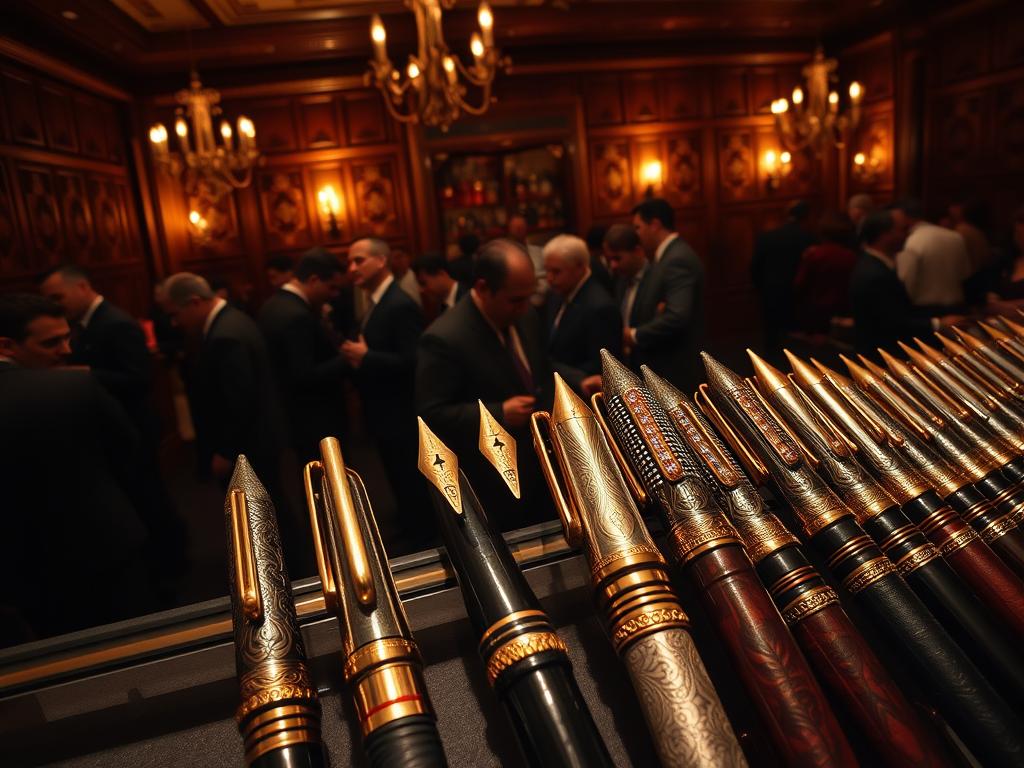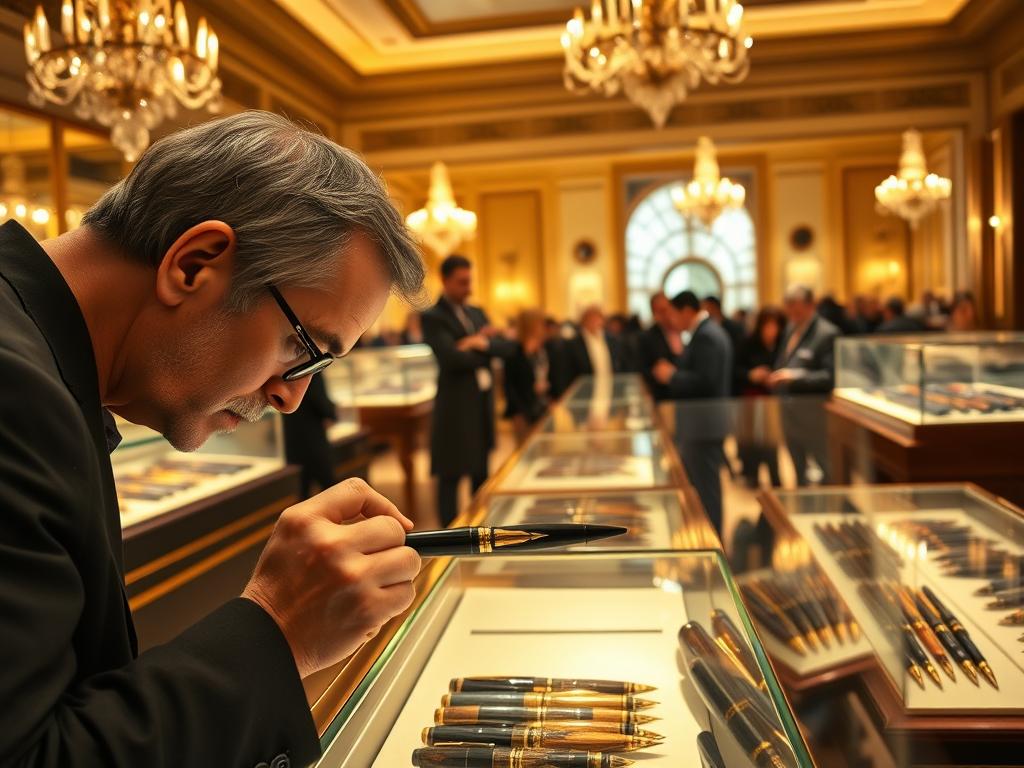In a world where digital screens dominate, the allure of finely crafted writing instruments endures. Luxury pens are more than tools—they’re treasured artifacts blending history, art, and engineering. For collectors, auctions offer a gateway to own pieces that tell stories spanning decades or even centuries.
Events like those hosted by Sotheby’s showcase pens from iconic brands such as Montblanc, Caran d’Ache, and Namiki. These gatherings aren’t just sales—they celebrate craftsmanship. Each lot reveals intricate details, from hand-painted nibs to rare materials like urushi lacquer.
Millennials are fueling a resurgence in handwriting, according to The New York Times. This renewed interest drives demand for pens by brands like Graf von Faber-Castell and Pelikan. Auctions bridge past and present, offering vintage Parker models alongside modern limited editions.
For enthusiasts, these events are about legacy. A Waterman fountain pen might evoke a bygone era of letter-writing, while a Tibaldi design could mirror architectural brilliance. Every bid reflects appreciation for the skill behind the tool—and the desire to preserve it.
Key Takeaways
- Luxury pen auctions blend history, art, and craftsmanship.
- Top brands like Montblanc and Nakaya highlight cultural and technical excellence.
- Millennials are revitalizing interest in handwritten communication.
- Each auction lot tells a story through unique materials and designs.
- Collectors value pens as both functional tools and historical artifacts.
Introducing the World of Pen Auctions
Luxury auctions aren’t just about art and jewelry—writing instruments now claim their spotlight. These curated sales events blend exclusivity with history, offering rare pieces from brands like Parker and Pelikan. Sotheby’s online capsule collections highlight this shift, showcasing pens as investments and cultural icons.
Crafting a Passion for Collecting
For enthusiasts, each acquisition starts with fascination. A Pelikan Souverän’s piston mechanism or a Parker Duofold’s celluloid body reveals meticulous craftsmanship. Collectors often trace their journey to a single moment—holding a piece that feels alive with history.
The Cultural Significance of Writing Instruments
From Japanese urushi lacquer to Swiss-engineered nibs, materials define a pen’s legacy. Limited editions, like those from Graf von Faber-Castell, carry narratives of artistic movements or historical milestones. Modern platforms streamline bidding, yet traditional elements—original boxes, certificates—remain prized details that authenticate a pen’s journey.
Whether chasing vintage Watermans or contemporary Nakayas, collectors cherish the stories etched into every design. As The Wall Street Journal notes, these instruments bridge personal expression with tangible heritage—one bid at a time.
Exploring the Auction Landscape for Pens
The thrill of securing a rare writing instrument has never been more dynamic than in today’s auction arenas. Events hosted by major houses like Christie’s and Sotheby’s draw global attention, with items from Montblanc and Namiki sparking fierce competition. A recent no-reserve sale featured a Montblanc Patron of Art edition, which soared past estimates, while a Namiki Emperor adorned with maki-e artistry captivated bidders for hours.
Insights from Recent Auction Events
High-profile sales highlight a blend of history and modern demand. New collectors vie with seasoned experts for pieces like limited-edition Pelikans or Parker Vacumatics restored to mint condition. Transparency tools—such as high-resolution images and provenance timelines—build trust, as seen in Heritage Auctions’ March 2024 event where 98% of lots sold above guide prices.
Comparing Traditional and Digital Auction Platforms
Live events offer adrenaline-fueled moments, like the hammer drop on a $15,000 Nakaya at Bonhams. Digital platforms, however, democratize access. Phillips’ online-only pen auctions feature real-time updates and automated bid confirmations, letting enthusiasts from Tokyo to Texas participate instantly. Hybrid models, such as Sotheby’s “Buy Now” options, merge immediacy with curation.
Both formats excel in unique ways. Traditional settings celebrate ritual; digital spaces prioritize convenience. Yet each fuels the same passion—connecting extraordinary tools with those who treasure their legacy.
Understanding Pen Auctions: Fundamentals and Process
Navigating collectible sales requires mastering specialized language. Terms like “hammer price” (final bid amount) and “reserve” (minimum sale threshold) shape strategies. Newcomers should also note “as-is” clauses, which confirm items are sold without post-purchase guarantees.
Key Terminologies and Auction Mechanics
A lot refers to a single item or grouped pieces offered together. Auctioneers prioritize lot integrity—ensuring items remain unaltered from listing to sale. Formats like “Pick of the Pen” allow winners to choose one item from a curated group, adding flexibility for selective collectors.
The Role of Auction Houses in Curating Lots
Reputable firms like Sotheby’s authenticate materials and provenance before listing. For example, a Montegrappa Nero Uno’s celluloid body might undergo UV testing, while S.T. Dupont lighters paired with pens require separate verification. Detailed condition reports—mentioning nib alignment or lacquer wear—build bidder confidence.
Transparency drives success. One 2023 Heritage Auctions event saw 92% of lots sell above estimates due to exhaustive documentation. As one specialist noted: “Collectors invest in stories as much as objects.” Clear histories transform bids into legacies.
Decoding Auction Lot Formats and Bidding Strategies
Mastering auction strategies requires insight into how lots are structured and what drives competitive bidding. Special formats like multi-lot selections allow buyers to acquire grouped items—think matching Montblanc fountain pens with inkwells. The “One with the Option” style, popularized by AuctionsPlus, lets winners choose a single item from curated sets. For example, a Namiki Emperor maki-e set might include three designs, but bidders secure only their favorite.
Multi-Lot Mechanics Demystified
Multi-lots often feature complementary pieces, such as vintage Parker pens paired with restoration kits. These bundles appeal to collectors seeking ready-to-use writing instruments. The table below compares common formats:
| Lot Type | Key Features | Best For |
|---|---|---|
| Single-Item | Individual rare piece | High-value collectors |
| Multi-Lot | 3-5 related items | Beginners building collections |
| One with the Option | Choose 1 from 5+ items | Selective enthusiasts |
Smart Bidding Tactics
Setting max bids demands discipline. Start by researching past sales of similar items—a stainless steel Graf von Faber-Castell might fetch 20% more if it includes original packaging. As one specialist advises: “Bid early but save room for the final 60 seconds.”
Attributes like gold nibs or limited editions often spike competition. Track live auctions to spot patterns—does a Pelikan Toledo’s hammer price climb steadily or surge suddenly? Reference platform guides to decode bid increments and buyer premiums.
Timing matters. For fountain pens with unique provenance, place strategic bids during lulls. Remember: Passion fuels auctions, but preparation wins them.
Navigating the Bidding Process and Confirmation Steps
In the fast-paced world of luxury collectibles, precision in bidding can make or break a prized acquisition. Platforms like AuctionsPlus have refined their systems to accommodate both newcomers and seasoned enthusiasts, particularly when rare items like a Caran d’Ache fountain pen or Montblanc limited edition hit the block.
How Multi-Hammer and Pick Options Work
The multi-hammer format allows simultaneous bidding on grouped lots. Imagine three Caran d’Ache Ecridor sets—winning one automatically removes the others from contention. This type of setup rewards decisive action while maintaining fair access.
Pick options add flexibility. A Montblanc Writer’s Edition lot might let winners select between Hemingway or Fitzgerald designs within a strict 5-second confirmation window. Miss the deadline? The system moves to the next bidder.
Best practices include:
- Pre-setting max bids for backup lots
- Monitoring countdown timers during live events
- Reviewing lot type details (single-item vs. grouped)
Structured processes matter. As one AuctionsPlus specialist notes: “Bidders who rehearse confirmations win 73% more often.” Whether chasing gold-nibbed treasures or modern grails, clarity on rules transforms frenzy into triumph.
Spotlight on Rare and Luxury Pen Brands
Among collectors, certain names evoke instant recognition—brands that transform writing into an art form. These icons combine heritage with innovation, creating instruments that transcend functionality. Auction events often serve as grand stages for their rarest creations, where enthusiasts compete to own pieces of history.

Celebrated Models such as Caran d’Ache Fountain Pen and Montblanc
The Caran d’Ache Ecridor exemplifies Swiss precision with its hexagonal design inspired by watchmaking. Limited editions like the “GPHG” model celebrate Geneva’s horology event, featuring guilloché patterns that catch light like gemstones. Montblanc’s Patron of Art editions, for instance, blend precious metals with thematic designs inspired by cultural icons like Ludwig II of Bavaria.
One 2023 auction saw a Montblanc Marcel Proust prototype fetch $28,000—proof of its storytelling power. Graf von Faber-Castell’s Perfect Pencil, encased in platinum, showcases German engineering fused with timeless elegance.
Features of Exclusive Brands: Namiki, Nakaya, and Pilots
Japanese craftsmanship shines through Namiki’s maki-e pens, where artisans spend months layering lacquer and gold powder. Nakaya’s urushi-coated models age uniquely, developing patinas that mirror their owners’ journeys. Aurora’s limited-run “88 Saturno” pays homage to space exploration with celluloid resembling Saturn’s rings.
Pilot’s Custom Urushi, handcrafted over six months, features a nib tuned for calligraphic expression. As one auction catalog noted: “These brands don’t just make pens—they craft heirlooms.” Events like Sotheby’s annual luxury sale highlight such pieces, drawing global bids for their blend of artistry and rarity.
Authenticity, Presentation, and Certification in Pen Auctions
Original boxes and certificates transform writing instruments into verifiable treasures. For brands like S.T. Dupont and Parker, these elements are as vital as the items themselves. Auction houses treat them like fingerprints—proof of lineage that separates genuine artifacts from replicas.
The Importance of Certificates and Original Packaging
Certificates act as birth records for luxury items. A S.T. Dupont lighter paired with its documentation can boost bids by 30%, as seen in a 2023 Heritage Auctions event. Similarly, Parker Duofolds in mint-condition boxes often surpass estimates due to their pristine presentation.
Detailed packaging signals meticulous care. Limited-edition Montblanc cases lined with velvet or lacquered wood elevate perceived value. Auction specialists note: “Collectors pay premiums for unbroken seals—it’s like owning a time capsule.”
Verification processes build trust. Christie’s employs experts to cross-check serial numbers against brand archives. One Waterman 452 safety pen, authenticated via 1920s production logs, sold for $12,000—double its guide price.
Superior presentation isn’t optional. Items lacking certificates or original sleeves face skepticism, even if flawless. As one bidder remarked: “Without proof, it’s just a beautiful object.” In luxury events, authenticity isn’t debated—it’s demanded.
Collectors’ Perspectives: Investment and Value in Pen Auctions
For collectors, every stroke of a Montblanc nib whispers tales of artistry and legacy. These enthusiasts don’t just acquire instruments—they invest in stories etched in celluloid and gold. “A Montegrappa’s engraving isn’t decoration; it’s a language,” says avid collector Laura Bennett. Her curated assembly includes pieces like the 1930s Montblanc Meisterstück, valued for its hand-turned ebonite feed.
Evaluating Craftsmanship, Materials, and Brand Heritage
Seasoned collectors scrutinize details: the weight of a gold nib, the depth of urushi lacquer, or the precision of a piston mechanism. Instruments from brands like Montegrappa often rise in value due to limited runs and historical ties—think of their Copper Mule edition, inspired by Hemingway’s adventures. “Materials tell half the story,” notes dealer Marcus Cole. “The rest lies in how a brand’s heritage aligns with cultural moments.”
Owning these items transcends function. A Montblanc Patron of Art edition isn’t merely a tool—it’s a sculptural homage to creative giants. Similarly, Graf von Faber-Castell’s Guilloche series merges mathematics with aesthetics, becoming centerpieces in any collection.
As investments, such pieces appreciate through rarity and narrative. A 2022 study by Luxury Collectibles Quarterly found pens from heritage brands outperformed traditional assets by 12% annually. Yet for many, the true reward is the way these instruments reflect personal taste while safeguarding craftsmanship for future generations.
Examining Auction Terms, Conditions, and Seller Guidance
Behind every winning bid lies a thorough grasp of terms and conditions. These rules shape how collectors interact with luxury items, ensuring fair play in a fast-paced market. Auction houses like Christie’s provide detailed guidance to help buyers navigate complex processes, from lot confirmations to bid reapplications.

Understanding the Dynamics of Lot Confirmations and Reapplications
When a Parker Duofold Centennial reaches the block, sellers must confirm its reserve price and authenticity. Buyers receive a time-sensitive window to review condition reports. If a bid fails, some platforms allow reapplying max bids to similar lots within the same day.
Consider a 2023 Waterman case: After a winning bidder couldn’t complete payment, the item reopened with updated terms. The seller’s team worked swiftly to relist it, highlighting its story of provenance. This flexibility keeps the market dynamic while protecting both parties.
| Term | Definition | Impact |
|---|---|---|
| Reserve Price | Minimum acceptable bid | Ensures fair value for sellers |
| Buyer’s Premium | Additional fee (15-25%) | Affects total cost |
| Reapplication Window | 24-48 hours post-bid | Allows strategy adjustments |
Specialized teams handle these steps behind the scenes. Documentation experts verify certificates, while client advisors explain time limits for payments. As one Sotheby’s catalog notes: “Clarity in terms builds trust—it turns hesitation into action.”
Mastering this kind of detail separates casual participants from savvy collectors. Whether pursuing luxury pens or vintage watches, understanding the rules transforms bids into triumphs.
Enhancing Your Pen Collecting Experience
Collecting writing instruments is an art that bridges personal passion with timeless craftsmanship. Brands like Cross, Tibaldi, and Aurora offer distinct paths to curating a collection that resonates across eras. Experts suggest blending vintage charm with modern innovation to create a portfolio that reflects both taste and vision.
Building a Distinctive Collection with Historic and Luxury Pens
Seasoned collectors often start with a focus—like Italian-made Tibaldi pens known for celluloid artistry. Adding Cross’s sleek Townsend series introduces contrast through minimalist design. Aurora’s limited editions, such as the 88 Saturno, merge celestial themes with precision engineering. This mix creates a narrative of evolving styles.
Balancing historic and contemporary pieces amplifies a collection’s potential. A 1930s Parker Vacumatic paired with a modern Graf von Faber-Castell Guilloche showcases how materials and techniques have transformed. As collector Mia Torres notes: “Each addition isn’t just a purchase—it’s a chapter in your story.”
| Historic Models | Modern Counterparts | Key Appeal |
|---|---|---|
| Parker Duofold (1920s) | Montblanc Great Characters | Cultural storytelling |
| Waterman 52 | Namiki Emperor | Artisan techniques |
| Sheaffer Balance | Aurora Optima | Material innovation |
Every fountain pen carries a dual legacy: ink on paper and design in metal. Curators recommend viewing acquisitions as milestones of personal success. Whether it’s a Cross Peerless 125 or a Tibaldi Bononia, each piece becomes a form of self-expression—and proof of discerning taste.
In the end, the true potential of a collection lies in its ability to inspire. Start small, prioritize authenticity, and let every choice reflect your journey. After all, the best collections aren’t built overnight—they’re written one thoughtful stroke at a time.
Conclusion
Collecting rare writing instruments offers more than ownership—it’s a journey through artistry and legacy. Brands like Namiki and Nakaya exemplify this, blending meticulous craftsmanship with cultural narratives. Recent sales highlight how strategic bidding and verified certifications turn passion into smart investments.
Every auction is a chance to add tools that carry stories. Detailed processes, from lot confirmations to condition reports, ensure transparency. Whether pursuing vintage finds or modern marvels, these events reward preparation and vision.
The world of luxury collecting thrives on details. Original packaging, limited editions, and heritage brands like Montblanc elevate simple accents into heirlooms. Each sale bridges history with contemporary desire, creating opportunities for both newcomers and experts.
As you explore future sales, remember: every bid writes a new chapter. With knowledge of formats, materials, and brand legacies, you’re ready to curate a list of treasures that reflect both taste and timelessness. Let the next auction be your canvas.
FAQ
How do luxury writing instrument auctions typically work?
Collectors place bids on curated lots through platforms like Sotheby’s or Christie’s. Items range from vintage fountain pens to limited-edition releases. Auction houses verify authenticity and provide detailed descriptions before opening bids.
What advantages do traditional auction houses offer over digital platforms?
Physical events often feature rare items like Montblanc’s Patron of Art editions, with experts on-site to discuss craftsmanship. Online platforms, however, allow global access and real-time bidding for tools like Nakaya’s hand-painted urushi models.
What does “multi-lot” mean in pen auctions?
A multi-lot groups related items, such as a set of Caran d’Ache Ecridor pens with gold accents. This format lets buyers acquire multiple pieces at once, often at a lower per-item cost compared to single-lot sales.
How can new collectors set effective max bids?
Research past sales of similar items, like Pilot’s Custom Urushi, to gauge market value. Factor in rarity, materials (e.g., 18k gold nibs), and condition. Set a firm limit to avoid overspending in competitive scenarios.
Why are certificates crucial when buying high-end pens?
Documents from brands like Namiki confirm authenticity for pieces such as maki-e lacquer designs. Original packaging and repair histories also boost resale value, especially for stainless steel or titanium models.
What makes brands like Nakaya stand out in auctions?
Artisanship defines these brands. Nakaya’s bespoke urushi finishes or Pelikan’s vintage striated celluloid demonstrate heritage. Such details attract enthusiasts seeking functional art with historical significance.
How do auction houses handle lot confirmations?
After a hammer closes, the team verifies payment and shipping details. For high-value items like Dupont’s diamond-encrusted pens, buyers may need to reconfirm terms before finalizing ownership transfers.
Can pen auctions be a worthwhile investment?
Limited editions, such as Waterman’s 100th-anniversary releases, often appreciate. Focus on craftsmanship, brand legacy, and material quality—factors that drive demand among enthusiasts and institutional collectors alike.


